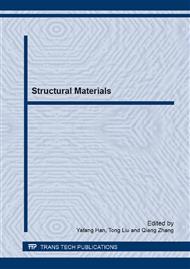p.311
p.317
p.323
p.329
p.334
p.340
p.346
p.351
p.357
Effects of Strain Rate on Dynamic Strain Aging of SA508-III Steel
Abstract:
The dynamic strain aging (DSA) behavior of SA508-III steel was evaluated through tensile tests with different strain rates from 10-4 to 10-1s-1 at 350°C. The OM, SEM and TEM were carried out to observe the microstructures and fracture morphologies of the steel. The results show that the serrated flows appear in the stress-strain curves when the strain rate is between 10-3~10-2s-1, indicating that DSA occurs. Under the strain rate range, the tensile strength increases and the elongation and the reduction of area decrease. However, the fracture surface of the steel after tensile tests is still ductile. DSA in SA508-III steel at the strain rates from10-3 to 10-2s-1 is mainly caused by the interaction between the internal solute atoms and dislocations, which leads to the dislocations multiplication and the formation of sub-grain boundaries and dislocation cell structure.
Info:
Periodical:
Pages:
334-339
Citation:
Online since:
April 2014
Authors:
Price:
Сopyright:
© 2014 Trans Tech Publications Ltd. All Rights Reserved
Share:
Citation:


